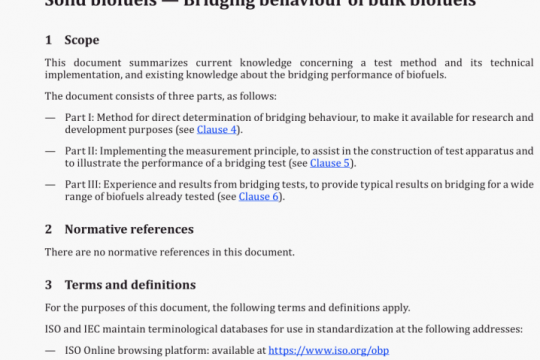ISO 19935-3 pdf free download
ISO 19935-3-2021 pdf free download.Plastics – Temperature modulated DSC – Part 3: Separation of overlapping thermal transitions.
This document specifies a method for the separation of overlapping thermal transitions of plastics related to reversing and non-reversing heat flow rate, using temperature modulated differential scanning calorimetry.
2 Normative references
The following documents are referred to in the text in such a way that some or all of their content constitutes requirements of this document. For dated references, only the edition cited applies. For undated references, the latest edition of the referenced document (including any amendments) applies.
ISO 472, Plastics — Vocabulary
ISO 113574, Plastics — Differential scanning calorimetry (DSC) — Part 1: General principles
ISO 19935-1, Plastics — Temperature modulated DSC — Part 1: General principles
ISO 19935-2:2020, Plastics — Temperature modulated DSC — Part 2: Measurement of specific heat capacity c,
ISO 80000-5, Quantities and units — Part 5: Thermodynamics
3 Terms and definitions
For the purposes of this document, the terms and definitions given in ISO 472, ISO 11357-1, ISO 19935-1 and 150 80000-5 apply.
ISO and IEC maintain terminological databases for use in standardization at the following addresses:
— ISO Online browsing platform: available at https://www .orgJobp
— IEC Electroped Ia: available at http://www.eIectropedia.org/
4 Symbols
4.1 Temperature modulation, T(t)
According to ISO 19935-1.
4.2 Heating rate
According to ISO 19935-1.
4.3 Heat flow rate, c1(t)
According to ISO 19935-1.
5 Principles
According to ISO 1993 5-1.
The total heat flow rate signal is separated into a reversing and a non-reversing component by means of modulation of the heating rate. The reversing heat flow rate corresponds to the heat capacity component while the non-reversing heat flow rate corresponds to the kinetic component of the total heat flow rate.
Separation is limited to overlapping effects related to reversing (heat capacity) component and non- reversing (kinetic) component, respectively, on the time scale of modulation.
6 Apparatus and materials
The apparatus and materials shall be in accordance with ISO 19935-1.
7 Calibration
7.1 General
According to ISO 19935-1.
7.2 Calibration procedure According to ISO 19935-2.
7.3 Calibration of modulation amplitude Accor ding to ISO 19935-1.
7.4 Calibration of phase According to ISO 19935-1.
8 Procedure
8.1 General
The procedures of temperature modulated DSC, setting up the apparatus, loading the specimen into the crucibles, insertion of crucibles into the instrument, performing measurements, and removal of crucibles, shall be In accordance with ISO 11357-1.
8.2 Experimental conditions
According to ISO 19935-2.
The determination of reversing and non-reversing specific heat capacity shall be done in accordance with ISO 19935-1.
83 Interpretation of results
According to ISO 19935-1.
8.4 Examples of the results — Separation of reversing and non-reversing heat flow rate Figure 1 shows a typical example of quenched polyethylene terephthalate (PET). ISO 19935-3 pdf download.




